Lyons W.C. (ed.). Standard handbook of petroleum and natural gas engineering.2001- Volume 1
Подождите немного. Документ загружается.

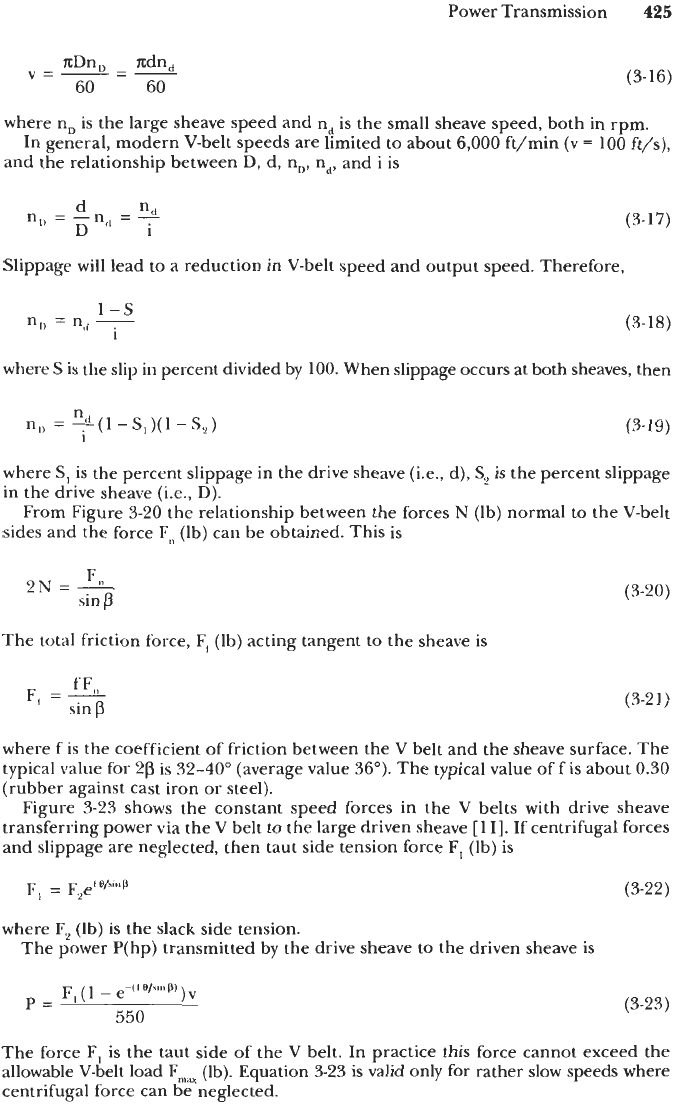
Power Transmission
425
nDn,
-
ndn,
60
60
v=---
(3-16)
where nu is the large sheave speed and nn is the small sheave speed, both in rpm.
and the relationship between
D,
d, nD, nn, and i is
In general, modern V-belt speeds are limited to about
6,000
ft/min
(v
=
100
ft/s),
Slippage will lead to a reduction in V-belt speed and output speed. Therefore,
(3-17)
(3-18)
where
S
is
the slip in percent divided by
100.
When slippage occurs at both sheaves, then
nI,
=
-s,)(I
-s?)
(3-19)
1
where
SI
is
the percent slippage
in
the drive sheave (Le., d),
S,
is
the percent slippage
in the drive sheave (i.e.,
D).
From Figure
3-20
the relationship between the forces
N
(Ib) normal to the V-belt
sides and the force F,, (lb) can be obtained. This is
The total friction force,
F,
(lb) acting tangent to the sheave is
(3-20)
(3-21)
where
f
is
the coefficient
of
friction between the
V
belt and the sheave surface. The
typical value for
2p
is
32-40"
(average value
36").
The typical value off is about
0.30
(rubber against cast iron or steel).
Figure
3-23
shows the constant speed forces in the
V
belts with drive sheave
transferring power via the V belt to the large driven sheave
[
113.
If centrifugal forces
and slippage are neglected, then taut side tension force
F,
(Ib) is
F,
=
~,~fe/-iii8
(3-22)
where
F,
(lb) is the slack side tension.
The power P(hp) transmitted by the drive sheave to the driven sheave is
(3-23)
The force
F,
is the taut side of the
V
belt. In practice this force cannot exceed the
allowable V-belt load F,,%= (Ib). Equation
3-23
is
valid only for rather slow speeds where
centrifugal force can be neglected.
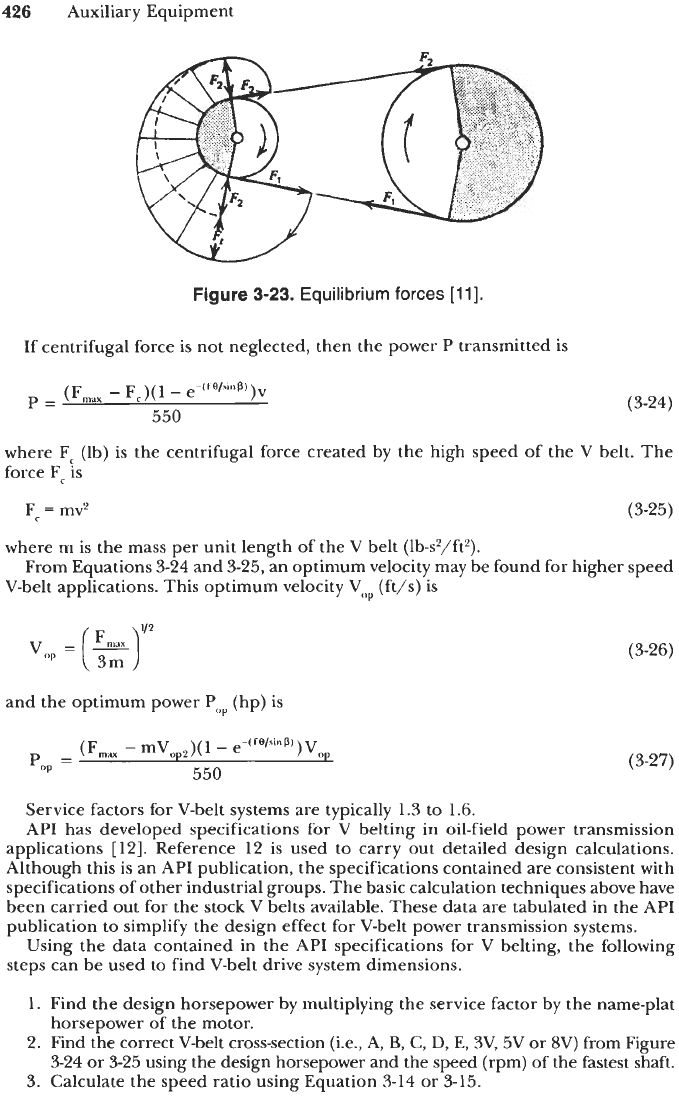
426
Auxiliary Equipment
Figure
3-23.
Equilibrium
forces
[ll].
If centrifugal force is not neglected, then the power
P
transmitted is
where Fc
(lb)
is the centrifugal force created by the high speed of the
V
belt. The
force F, is
F,
=
mv2 (3-25)
where m is the mass per unit length of the
V
belt (lb-s2/ft2).
V-belt applications. This optimum velocity Vop (ft/s) is
From Equations 3-24 and 3-25, an optimum velocity may be found for higher speed
Y2
v,,,
=
(k)
and the optimum power
Pop
(hp)
is
(3-26)
(3-27)
Service factors for V-belt systems are typically 1.3 to 1.6.
API has developed specifications for
V
belting in oil-field power transmission
applications [12]. Reference 12 is used to carry out detailed design calculations.
Although this is an API publication, the specifications contained are consistent with
specifications of other industrial groups. The basic calculation techniques above have
been carried out for the stock V belts available. These data are tabulated in the API
publication to simplify the design effect for V-belt power transmission systems.
Using the data contained in the API specifications for V belting, the following
steps can be used to find V-belt drive system dimensions.
1.
Find the design horsepower by multiplying the service factor
by
the name-plat
horsepower of the motor.
2.
Find the correct V-belt cross-section (i.e., A,
B,
C,
D,
E, SV, 5V
or
8V)
from Figure
3-24 or 3-25 using the design horsepower and the speed (rpm) of the fastest shaft.
3.
Calculate the speed ratio using Equation 3-14 or 3-15.
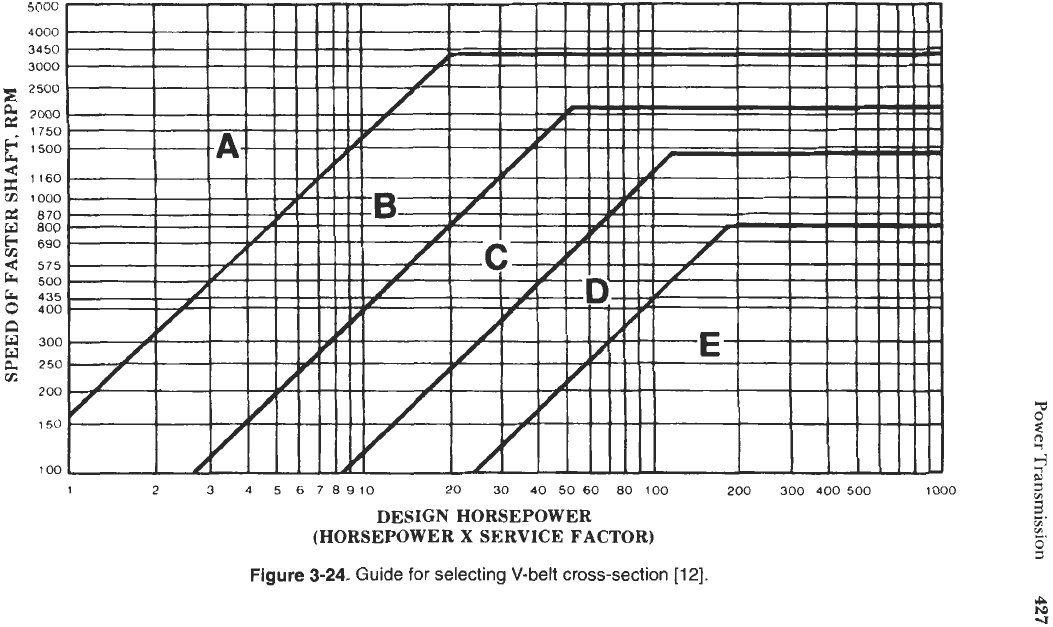
1
2
3
4
5
6
78910
20
30
40
50
60
80
100
200
300
400
500
1000
DESIGN
HORSEPOWER
(HORSEPOWER
X
SERVICE
FACTOR)
Figure
3-24.
Guide
for
selecting V-belt cross-section
[I
21.
cd
8
8
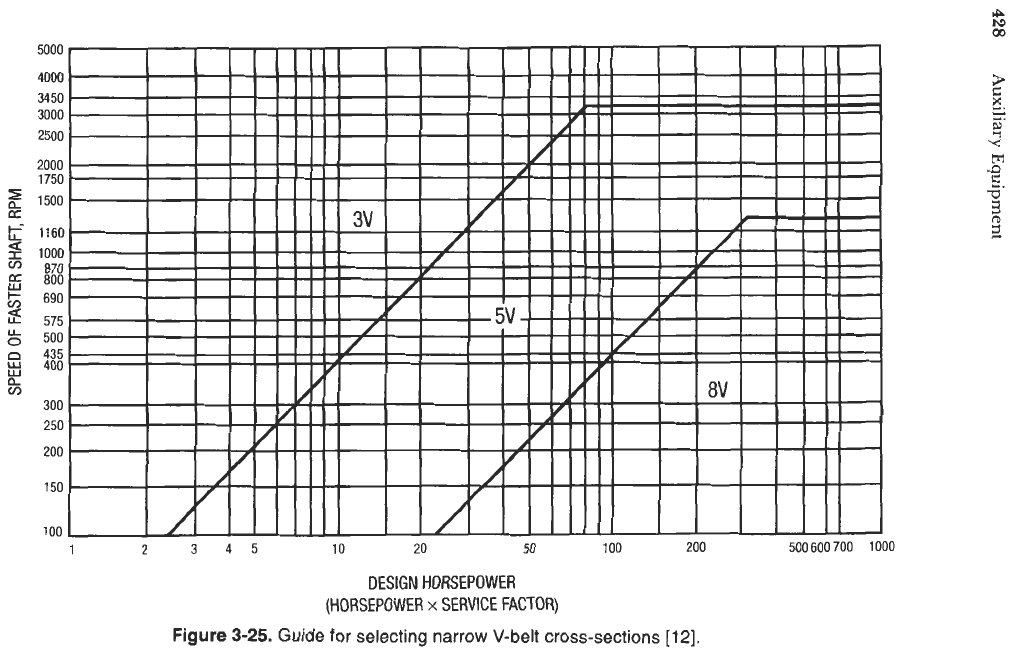
5000
4000
3450
3000
2500
2000
1750
1500
1160
1000
870
800
690
575
500
435
400
300
250
200
150
100
2
3 45
10
20
50
100
200
500600
700
1000
1
DESIGN
HORSEPOWER
(HORSEPOWER
x
SERVICE
FACTOR)
Figure
3-25.
Guide
for selecting narrow V-belt cross-sections
[12].
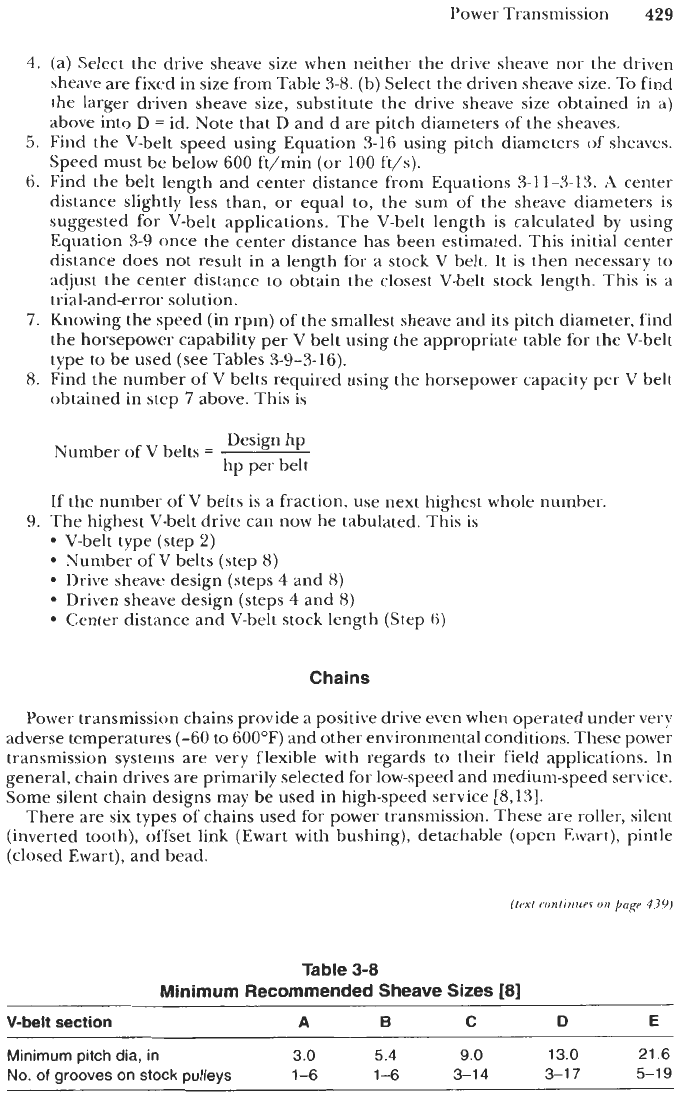
Power Transmission
429
4.
(a)
Select the drive sheave size when neither the drive sheave nor the driven
sheave are fixcd in size from Table
3-8.
(b) Select the driven sheave size. To find
the larger driven sheave size, substitute the drive sheave size obtained in
a)
above into
D
=
id. Note that
D
and d are pitch diameters
of
the sheaves.
5.
Find the V-belt speed using Equation
3-16
using pitch diameters
of
sheaves.
Speed must be below
600
ft/min (or
100
ft/s).
6.
Find the belt length and center distance from Equations
3-1
1
-3-E4. A
center
distance slightly less than, or equal to, the
sum
of the sheave diameters is
suggested for V-belt applications. The V-belt length is calculated by using
Equation
3-9
once the center distance has been estimated. This initial center
distance does not result in
a
length for a stock V belt. It is then necessary to
adjust the center distance
to
obtain the closest V-belt stock length. This is a
trial-and-error solution.
7.
Kntming the speed (in rpm) of the smallest sheave and its pitch diameter, find
the horsepower capability per V belt using the appropriate table
for
the V-belt
type to be used (see Tables
3-9-3-16).
8.
Find the number
of
V belts required using the horsepower capacity per
V
belt
obtained in step
7
above. This is
Design hp
hp per belt
Number of
V
belts
=
If
the number ofV belts is a fraction, use next highest whole number.
V-belt type (step
2)
Number
of
V
belts (step
8)
Ilrive sheave design (steps
4
and
8)
Driven sheave design (steps
4
and
8)
Center distance and V-belt stock length (Step
6)
9.
‘The highest V-belt drive can now he tabulated. This is
Chains
Power transmission chains provide a positive drive even when operated under very
adverse temperatures
(-60
to
600°F)
and other environmental conditions. These power
transmission systems are very flexible with regards
to
their field applications. In
general, chain drives are primarily selected for low-speed and medium-speed service.
Some silent chain designs may be used in high-speed service
[8,13].
There are six types of chains used for power transmission. These are roller, silent
(inverted tooth), offset link (Ewart with bushing), detachable (open Ewart), pintle
(closed Ewart), and bead.
Table
3-8
Minimum Recommended Sheave Sizes
[8]
V-belt
section
A
B
C
D
E
Minimum
pitch
dia,
in
3.0
5.4
9.0
13.0
21.6
No.
of
grooves
on
stock
pulleys
1-6
1-6
3-1
4
3-1
7
5-1
9
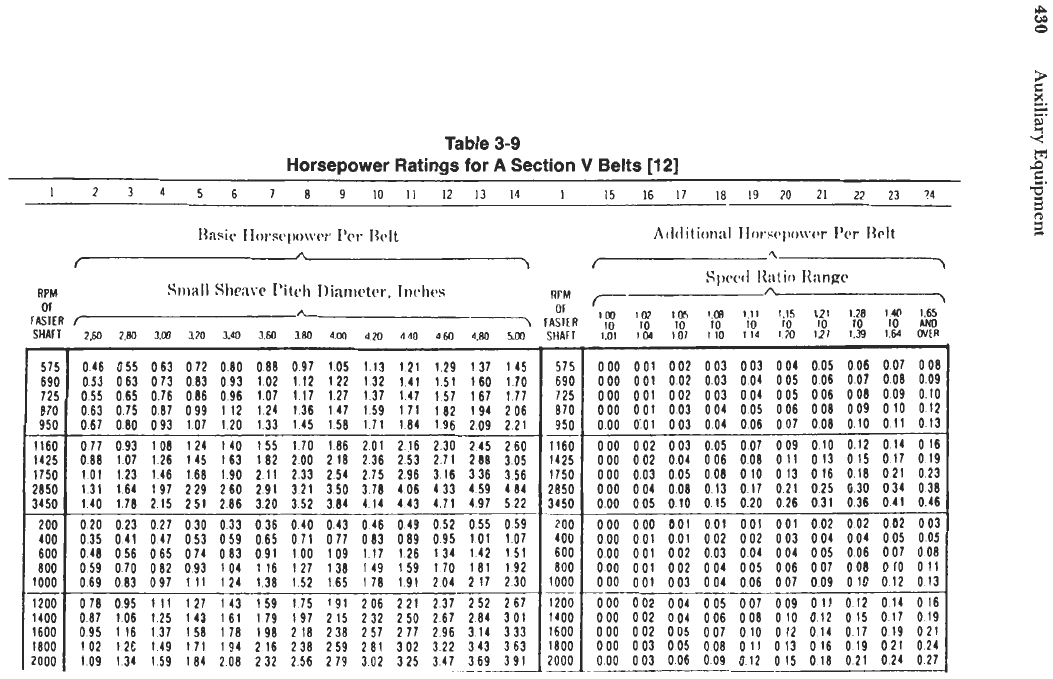
Table
3-9
Horsepower Ratings
for
A
Section
V
Belts
[12]
I
2
3
4
5
6
7
8
9
IO
I1
12
13
14
I
15
16
I7
18
19
20
21 22 23
?4
575
046
055
063
072
080
088
097
105
113
121
129
137
145
575
690
053 063
073
083
093
102
112 122
132
141
151
I60
170
690
725
055
065
076
086
096
IO7
117 127
137
147 157
I67
177 725
870
063
075
087 099
112
124
136
147
159
171
182
I94
206 870
950
067
080
093
107
120
133
145
158
171
184 196 209 221
950
1160
077 093
108
124
140
155 I70
186
201
216
230 245
260
1160
1425
088
107 126
145
163
182 200 218
236
253
271
288
305
1425
I750
101 123 146
168
190 211 233 254 275 296
316
336
356
1750
2850
131
164 197
229 260
291 321 350
378
406 433 459
484 2850
3450 140
178
215 251
286
320
352
384
414
443
471 497
522 3450
200
020
023
027
030
033
036
040
043
046 049 052
055
059 200
400
035
041
047
053
059
065
071 077
083
089
095
101
107
400
600
048
056
065
074
083
091
100
109 117 126
134 142
151
600
BOO
059 070 082
093
104
116
127
138
149 159
170
181
192
800
1000
069
083
097
111
124
138
152
165
178
191
204 217
230
1000
1200 078
095
111
127
I43
159 175
$91
206
221
237
252
267
1200
1400
087
106
125
143
161
179 197 215
232
250
267
284
301
1400
1600
095
116
137
158
178
198
218 238
257
277
296
314
333
1600
1800 102 12E t49
171 194
216 238 259
281
302
322
343
363
1800
2000
109
134
159
184
208 232 256 279
302 325
347
369
391
2000
___
___
000
001
002
003
003
004
005
006
007
008
000
001
002
003
004
005
006
007
008
009
000
001
002
003
004
005
006
008
009 010
000
001
003
004
005
006
008
009
010
012
000
001
003
004
006
007
008
010
011
013
000
002
003 005
007
009
010
012 014
016
000
002
004
006
008
011
013
015
017
019
000
003
005
008
010
013
016
018
021 023
000
004
008
013
017
021 025
030
034
038
000
005
010
015
020 026
031
036
041
046
000
000
001
001
001
001
002
002
002
003
000
001
001
002
002
003
001
004
005
005
000
001
002
003
004
004
005
006
007
008
000
001
002
004
005
006
007
008
010
011
000
001
003
004
006
007
009
010
012
013
000
002
004
005
007
009
011
012 014
016
000
002
004
006
008
010
012
015
017
019
000
002
005
007
010
012
014
017 019
021
000
003
005
008
011
013
016
019 021
024
000
003
006
009
012
015
018
021 024
027
2
5.
4
e:
Y
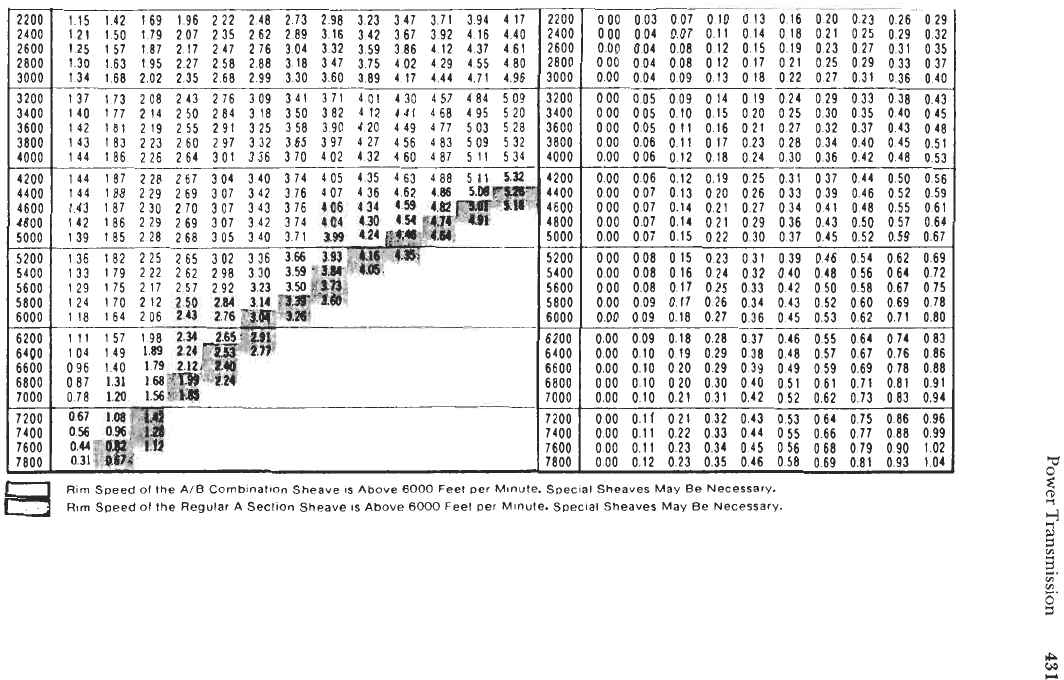
22001
115 142 169 196 222 248 273 298 3.23 347 371 394 417
.___
2400
2600
2800
3000
3200
3400
3600
3800
4000
4200
4400
4600
4800
5000
5200
5400
5600
-
_.
__
12i
125
130
1.34
137
140
142
143
144
-
150 179 207 235
157 187
217 247
163 195
227 258
168 202 235 268
173 208 243 276
177 214 250 284
181 219
255 291
183
223 260
297
186
226 264
301
144
144
143
142
139
136
133
129
-
187 228
267 304
188
229 269
307
187 230 270
307
186 229 269 307
185 228 268
305
182
225 265
302
179 222
262 298
175 217
257 292
262 289
316 342
367
392 416
440
276
304 332
359 386
412 437 461
288 318
347 375
402 429 455 480
299 330
360
389 417
444
471 496
309
341 371
401 430
457 484
509
318
350
382
412 441 468 495 520
325
358 390
420
449 477
503 528
332
365
397 427
456 483
509
532
336 370
402 432
460 467
511
534
340 374 405435 463 488
511
532
2200
2400
2600
2800
3000
3200
3400
3600
3800
4000
4200
4400
4600
4800
5000
5200
5400
5600
5800
6000
6200
6400
6600
6800
7000
7200
7400
7600
7800
__
-
-
-
-
-
~-
____
000
003 007
0
10
0
13
0
16 020 023 026 029
000
004
007 011 014 018 021 025 029 032
000 004
008 012 015 019 023
027 031
035
000
004 0.08
012 0.17 0.21 0.25 0.29
0.33 0.37
0.00
0.04
0.09 0.13
0
18
0.22 0.27
0.31
0.36
0
40
0 00
0.05
0.09
0
14
0.19 0.24
0.29 0.33 0.38 0.43
000
005
0.10
0
15
020 025
030 0.35 040 045
000
0.05
0.11
0.16
021 0.27 0.32 0.37 0.43 0.48
0.00
0.06
0.11
017 0.23 0.28 0.34 0.40 0.45
0.51
0.00
006
0.12
0.19 0.25 0.31
037 0.44
0.50
0.56
0.00
0.07
0
13
0.20
0.26 0.33 0.39 0.46 0.52
0.59
000
0.07
0.14
0.21 0.27
0.34 0.41 0.48
0.55
0.61
0.00
0.07 0.14
0.21 0.29 0.36 0.43
0.50
0.57
0.64
0.00
0.07
0.15
0.22
0.30
0.37 0.45 0.52
0.59 0.67
000
0.08 0.15
0.23
0.31
0.39
0.46
0.54
0.62 0.69
000
0.08
0.16
024 0.32
0.40
0.48 0.56
064 0.72
0.00
0.08 0.17
0.25
0.33 0.42
0.50
0.58
0.67 0.75
0
00
0.09
0.17
0.26 0.34
0
43 0.52
0.60
0.69 0.78
0.00
0.09
0.18 0.27
0.36 0.45
0.53
0.62 0.71
0.80
000
0.09
0.18 0.28
0.37 0.46
055
0.64 0.74 0.83
0.00
0.10 0.19
0.29 0.38
048 0.57
0.67 0.76 0.86
0.00
0.10
0.20 0.29
0.39
0.49
0.59
0.69 0.78
0.88
0.00
0.10
020
0.30
0.40
0.51
0.61
0.71
0.81 0.91
0.00
0.10 0.21
0.31
0.42
0.52
0.62 0.73
0.83 0.94
0.00
0.11
021 0.32 0.43
0.53
064
0.75 0.86
0.96
000
0.11
0.22
0.33 0.44
055
0.66
0.77
0.88 0.99
000
0.11
0.23 0.34 0.45 056 068 0.79
0.90 1.02
0.00
0.06 0.12 0.18 0.24 0.30 0.36 0.u 0.48
0.53
000
0.12 023
035
0.46
058 069 0.81 093 1.04
Rim Speed
of
the A/B Combinallon Sheave
IS
Above
6000
Feet per Minute. Spectal Sheaves May Be Necessary.
Rim Speed
of
the Regular A Sectlon Sheave
IS
Above
6000
Feel per Minute. Special Sheaves May Be Necessary.
a

Table
3-1
0
Horsepower Ratings for B Section
V
Belts
[12]
Mn
4~
480
sm
LZO
UQ
51
sdc
603
LZO
1(0
6~
680
im
IM
141 11
11
am
SHA~
575
162 177
191 205 219 233 247 261 275 289
302 316
330
343
357
370
384
397 575
690 187 204 221 237
254 270 286
303
319
335
351 367
383
399 415
430
446
461 690
725 194 212 229 247 264 281 298
315 332
349 365 382 399 415 432
448
464
480
725
870 223 244 264 284
304
324
344
364
384
403
423
442
461
481 500 518 537 556 870
950 238 260 282 304 326 347 369
390 411 432 453 474 494 515 535
555 576 596 950
1160 275 301 327 353 378
404
429 454 479 503 527 552 576 599 623
646
670 693 1160
1425 317
348
378
408
438
468
497 526 555 583 612 639 667 694 721 748 774
800
1425
1750 361 397 432 467 502 536 569 602 635 667 699 730 761 791 821 850 879 907 1750
2850 447 494 540 584 626 667 707 744 781 815
848
879 908 936 961 98510061026 2850
3450 450 497 543 586 627 665 700 733 763 790 814 835 3450
200
069 075
080
086
091 097 102
107 113 118 124 129 134 140 145 150 156
161 200
400
122 132 142 153 163 173 183 193 203 213 223 233 243
253 263
273 283
292
400
600
168 183
198 212 227 241 256 270 285 299 313 327 341 356 370
363
397 411
600
800
209 229 248 266 285
304
322 341 359 377
396
414
432 449 467 485 503
520
800
1000 247
270 293 316 339 361
384 406
428
450 471 493
514 536 557 578
599 620
1000
1200 282 309 335 362
388
414
440
465 491
516 541 566 590 615 639
663
686
710
1200
1400 313
344
374
403
433
462 491 520 548 576
604
632 659
686
712
739 765
791 1400
1600 341 375
408
441
474 506 538 569
600
631 661 691 720 749 776
806
834
861 1600
1800 367
103
440
475 510
545 579
613
646
679 711 743 774
804
834
864
893
921 1800
1000
389 428 467 505 543 579 616 651
686
720
754 787
819 851 881 911 941 969 2000
2200
408
450 491 531 570 609 647 684 720 755 789 823 856 887
916 948 9771005
2200
2400 424
468
510 552 593
633
672
710 747 782
817 851
883
914
945 974 1001 1028
2400
1600
436
482 526 569 611 652
691 729 766
802 836 869 901 931
960 987 1012 1036
2600
MOO
446
192 537 581 624 665
704 742
779 814 847
878 908 936
962 987 10091030
2800
io00
451
499 544 589 631
672 711 748
713 817
14.3
a77 904
930
953
973
992
3000
1200 453 501 547 591
633
673 711 746 780 811 839 865 889 911 929 3200
1400
451 499 544 588 629 667 703 736 767 795
820
843
3400
1600
445
492 537 579 618 655
686
718 746 770
3600
I800
434
481 524 564 601 665
692
3800
IO00
420 465 506 544 578
608
634
4000
1200 401 443 482 517 547 4200
1400
377
4
17 452 483
4400
1600
348
385 416
4600
I800
315 347
4800
~000
276 5000
1
Rim
Speed
Above
6000
Feel
Per
Mbnule.
Spec1.1
Sheaves
May
Be
Necessary.
I
2
3
4
5
6
1
8
9
IO
11
12
13
14
IS
I6 11
18
19
I
20
21
22
23
24
25
26
21
28
29
Basic
Horsepower Per
Belt
Additional
Horsqxwer Per
Belt
<
c
A
\
I
'r
101
io1
io1
iio
114
120
in
IS
1f~
wfn
000
002
004
007
009
011 013
016
018 020
000
003
005
008
011 013
016 019
022 024
000
003
006
008
011
014
017 020
023 025
000
003 007
010
014 017
020
024 027
030
000
004
007 011
015 019
022 026
030
033
000
005
009 014
018
023 027
032
036
041
000
006
011 017
022 028
033
039
044
050
000
007 014
020 027
034
041
048
055 061
000
011
022
033
044
056 067
078
089 100
000
013
027
040
054 067
081 094
108 121
000
001 002
002
003
004
005 005
006
007
000
002
003
005
006
008
009
011 012 014
000
002 005
007 009
012 014
016
019 021
000 003
006
009
012 016 019
022 025
028
000
004
008
012 016
019 023 027
031 035
000
005
009 014
019 023 028
033
037
042
000
005
011
016 022
027
033
038
044
041
000
006
012
019 025
031 037
044
050
056
000
007 014
021 028
035 042
049 056
063
000
008
016
023 031
039
047 055
062 070
000
009 017
026
034
043
051
060
069 077
000
009
019
028 037
047 056 065 075
084
000
010 020
030
040
051
061 071 081 091
000
011 022
033
044
055
065 076 087 098
000
012
023
035 047
058 070 082
094
105
000
012
025 037
050 062
075 087 100 112
000
013 026
040
053
066
079 093 106 119
000
014 028
042
056 070
084
098 112 126
000
015
030
044
059
074 089
104
118 133
000
016 031
047 062
078
093
109 125 140
000
016
033
049 065
082 098 115
131 147
000
017
034
052
069
086
103 120 137 154
000
018
036
054
072 090
107 125 143 161
000
019
037 056
075
094 112 131
150 168
000
019
039
059
078
097 117
136
156 175
rp
w
M
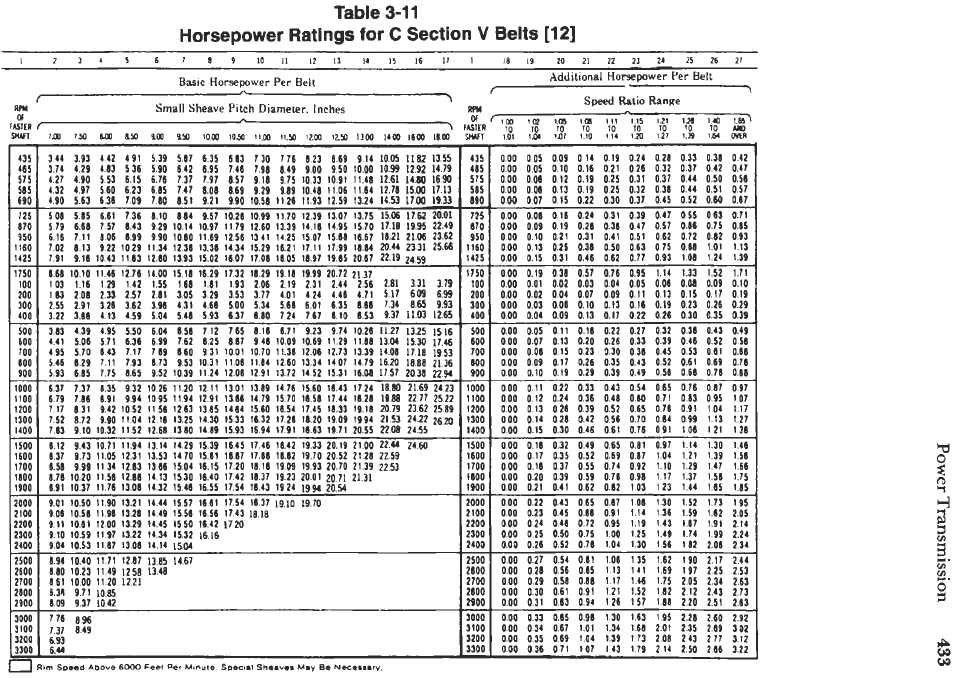
Table
3-11
Horsepower Ratings
for
C
Section
V
Belts
[12]
435
485
575
585
690
125
810
950
1160
1425
iiso
100
200
300
400
500
600
TOO
800
900
1000
1100
1200
1300
1400
1500
1600
1100
1900
2000
2100
2200
2300
2400
2500
2600
2700
2800
2900
3000
3100
1800
344 393
442 491 539
587
635
683
130
776 823 869 914
IOOS
1182
1355
435
314
429
413
536
590
642 695
746 798 849 900 950
I000
1099
1292 1419
485
421
490
553
615
676
137
197 857 916 975 1033 1091 1148
1261
1480
1690
515
432 491
560
623
685
147
801
869 929 989 1048 1106 I164
I218
15W
1713
585
490
563
636
709
780
851
921
990
IO58
1126 1193 1259 1124
1553
1700
1933
690
508
585
661 736 810
884
957 1028 1099
1110
1239 1307
1315
1506
1162
2001
125
579
668
157 143 929 1014 1097 1119 1260 1339 1418 1495 1570 Ill8 1995 2249 870
616 711
806
899 990 1080 1169 1256 1341 1425
1501
1588
1667
1821
2106 2362 950
102
813 922 1029 1134
1238
1336 1434 1529 1621 1711 1199
1884
2044
2331
2566
1160
191
918
1043
1163 1280 1393
1502
1607 1708
I805
1891
1985 2067
2219
2459
1425
860
ioio
1146 1216 1400
isla
1629
1132
1829 1918 1999 20122131
1150
103
116 129 142 155
168
181 193
206
219 231 244
256
281
331
319 100
183
208
233 251 281
305
329
353
317 401 424 448
411
517
603
b99
200
255 291 326
362
396 431 466
500 534
568
601
635
668
734
865 993
300
322
361
413 459
504
548 593 637
680
124
167 810
853
931
I103
I265 400
383
439 495
550
604
658
112
165
818 811 923 914
1026
1121
1325
IS16
500
441
506
511
636
699
162
825
881
948 1009 1069 1129
1188
1304
1530
114
600
495 570
643
717
189
860
931 1001
I010
1138 1206
I213
1339
1408
1718
1953
100
546
629 111
193
873
953 1031 1108
I184 1260
1334
1101
1479 1620
1888
2136
800
593
685
775
865
952 1039 1124 1208 1291 1372 1452
1531
1608
1751
2038
2294 900
631
131
135
932 1026 1120 I211 1301 1389 I476 1560 1643 1124
18(w
2169
2423 1000
619 786 891 994 1095 1194 1291 1386 I419 1570 1658 1144 1821 1988 2277
2522
1100
711 831 942 1052 1158
1263
1361
1464 1560
1654
1145 1833 1918 2079
2362
2589 1200
152
812 990 1104
I216
1325
1430 1533 1632 1728
1820
1909 1994
2153
2422262@
I300
783
910 1032 1152 1268
1380
1489 1593 1694 1791
103
1911
2055
2208
2455 1400
812 943 1011 1194 1314 1429 1539 1645 1746
1842
19332019 2100
2244
24M)
1500
831
913
110s
1231 $353 1410 15ai 1887 178a 1882 1910
2052
2128 2259 1600
858
999
1134
1263 1386 1504
1615
1720
1818
1909 1993
2010
2139
2253
1100
891 1037 1116
1308
I432
1548
I655
1754 1843 1924 19%
2054
1900
901 1050 1190 I321 1444 1557 1661 1754 1837
1910
1970
2000
908 1050 1198
1328
1449
1518
1656 1743
1818
2100
911 1061 1200 I329 1445
I550
1642
1720
2200
910 1059 1191 1322
1434
1532
1616
2300
904
1013
1187 1308 1414
15M
2400
894 1040
1171
1281
1385
1461
2500
880
10
23
11
49
I2
58
I3
48
2600
861 1000 1120
1221
2700
83n
9711085
2800
809 9371042 2900
1768%
3000
737 849
876 1020 1158
1281
1413 1530 1640 1742 1837 1923 2001
2071
2131
iaoo
3100
13200
000
005
009 014 019 024
011
033
031
042
000
005
010 016
021 026
032
031
042 041
000
006
012
019
025
031
037 044
050
056
000
006
013
019 025
032
031
044
051
051
000
007
015
022
030
031
045
052
060
06?
000
008
016
021
031
039 047
055
063
011
000
009 019
021
038
047
057
066
015
015
000
010
021 031
041
os1
062
on
012 093
000
013
025
038
050
063
on
088
io1
113
000
015
031
046
062
077
093
101
124 139
000
019
038
057 076
095 114
I33
152 I71
000
001
002
003
004
005
006
001
009
010
000
002
004
001
009
011
013
015 017 019
000
003 006
010
013
016 019
023 026 029
000
005
011
016
022
021
032
038
043
049
000
001
013
020
026
033
039
046
052
058
000
008
015
023
030
038
045
053
061
068
000
009 017
026
035
043
052
061
069
018
000
011 022
033
043
054
065
076
087 097
GOO
012
024
036
048
060
071
083
095
101
000
013
028
039
052
065 078 091
104 fll
000
014 028
042
056
010
084 099
113
121
000
015
030
046 061
016
091
I06
121 136
000
016
032
049
065
081
091
114
130
146
000
017
035
052
069
081
104 121 I39
156
000
018
031
055
074 092 110
129
147 166
000
020
039
059
018
098 111 131
158
115
000
021
041
062
082
103
123
144 165
I15
000
022 043
065
087
108
130
152
173
195
000
023
045
068
091 114
136
150
182
205
000
025
050
015
100
I25
149
I74 199
224
000
026
052
018
104
130
156
182
LO8
234
000
028
056
085
113 141 I69
191
225
153
000
029
058
088
111 146
I75
205
234
263
000
030
061
091 121
152
I82
212
243
213
000
031
063
094 126
I57
I88
220
251
283
000
033
065
098
130
I83
195
228
260
292
000
035
069
I04
139 113 201
243
277
312
000
036
011 107
143
I19
214 250
286
322
000
004
009
013
017
022
028
030
035
a30
000
010 019 029 039 049
058
068
018
oaa
000
024
048
on
09s
119 14s
161
191 214
000
021
054
oat
108
135
162
190 211 244
000
034 067
101
134
168
201
235
269 302
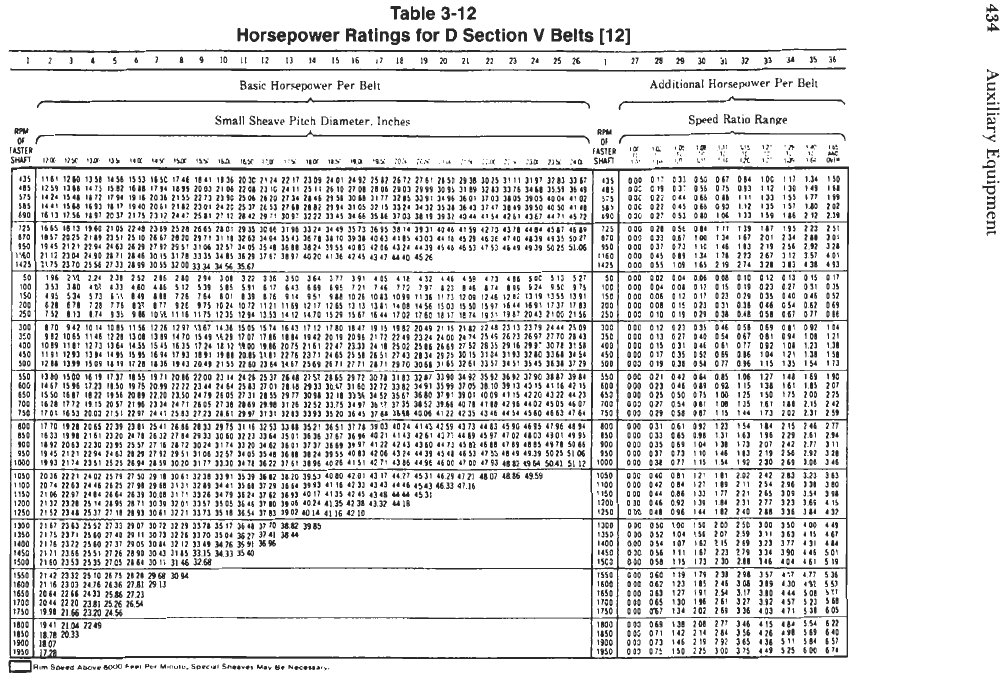
Table
3-12
Horsepower
Ratings
for
D
Section
V
Belts
[12]
I
2
1
4
5
6
7
I
9
10
II
12
13
14
15
16
11
le
19
M
21
22
23
24
25
26
I
27
2E
29
30
$1
32
33
Y
15
36
Basic Horsepower Per Belt
Additional
Horsepower
Per
Belt
r
\c
7
Small Sheave
Pitch
Diameter.
lnchep
RRI
C
rp
w
A
